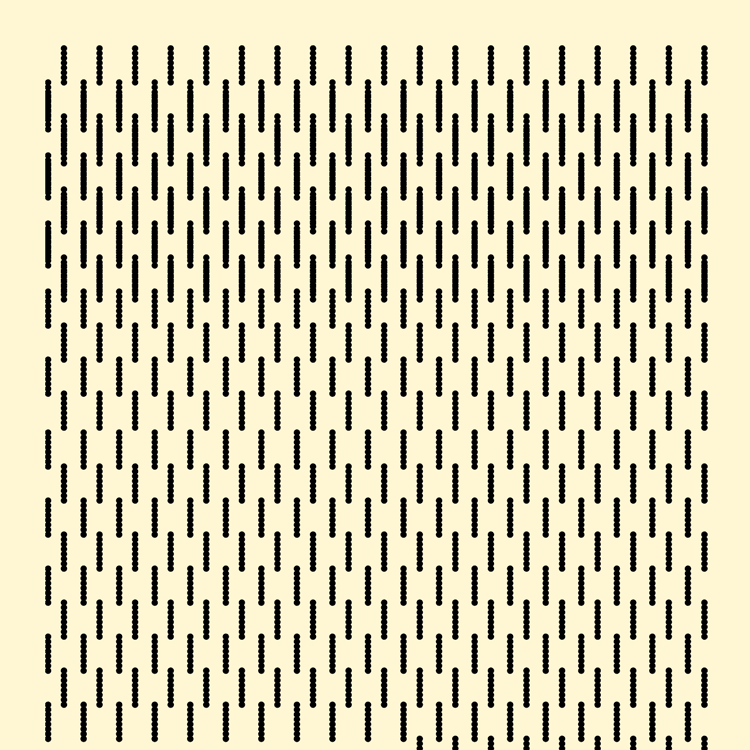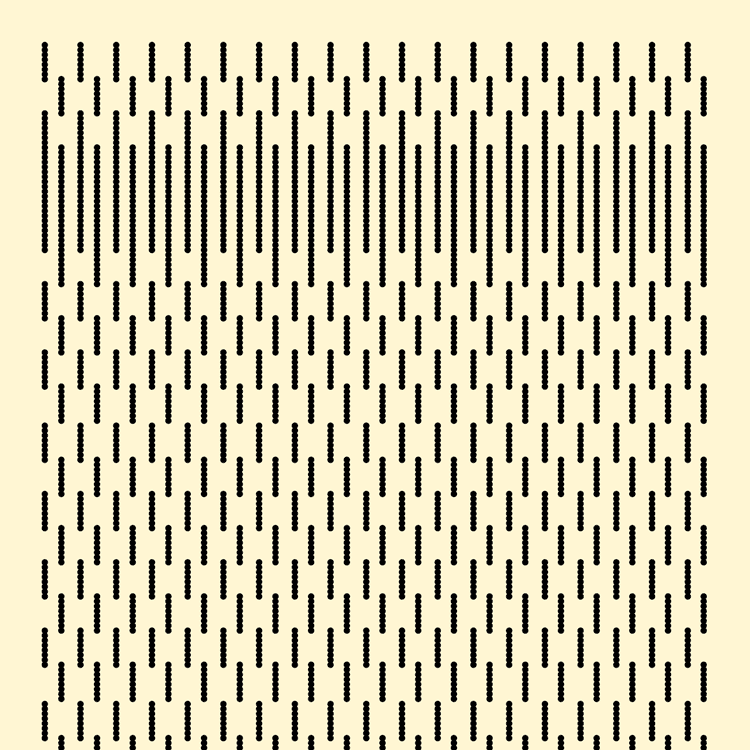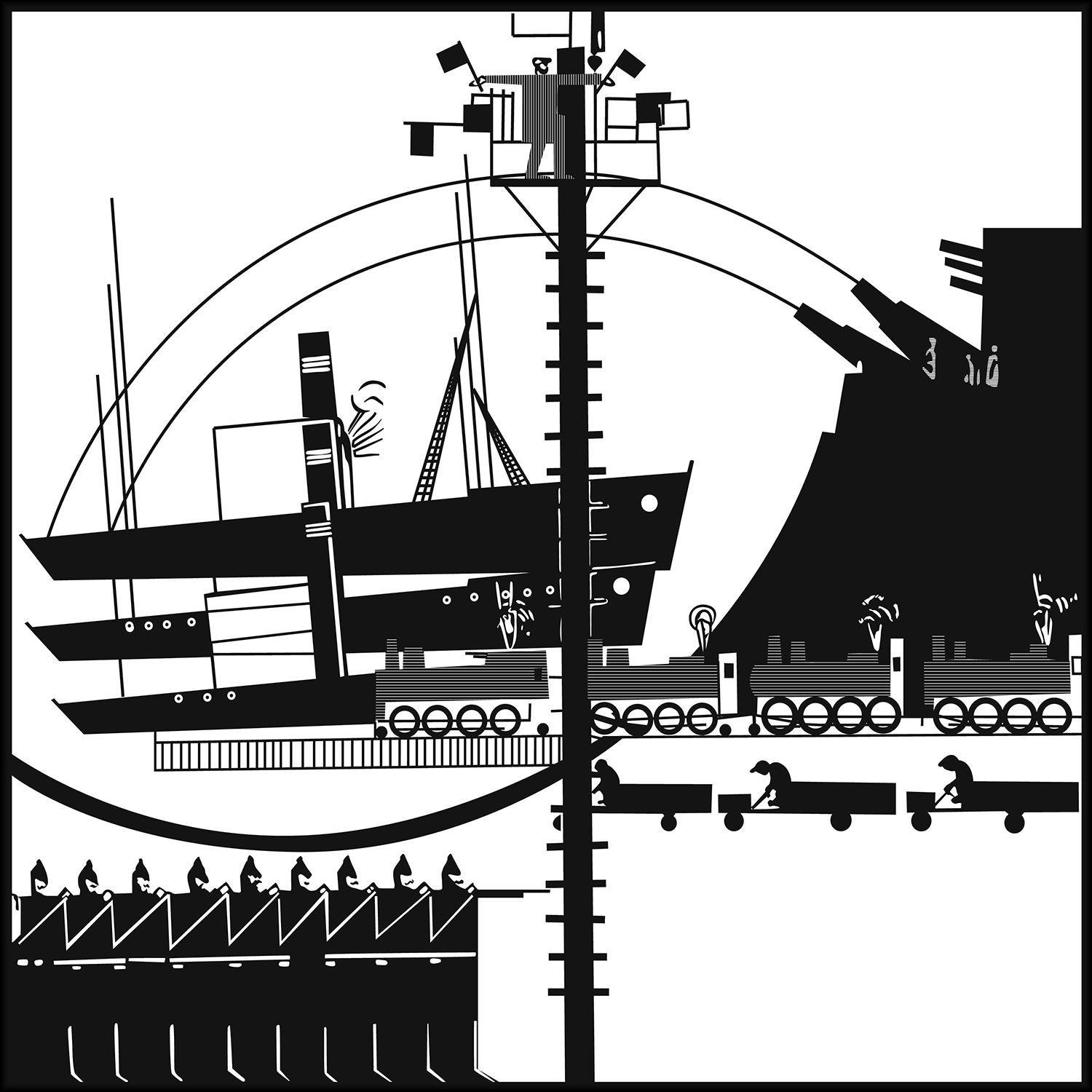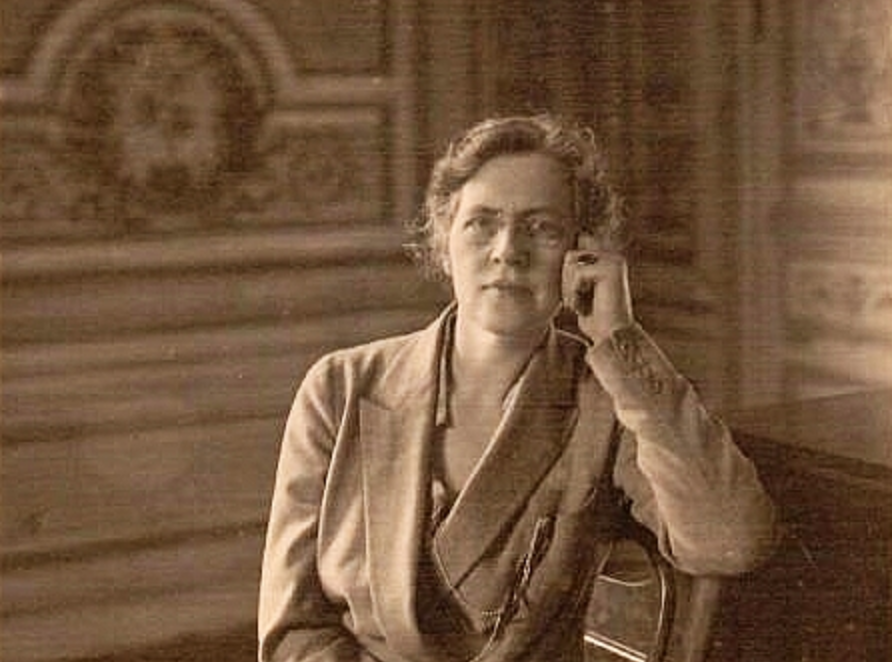
Palacio de Bellas Artes, Mexico City, 1962. A large wooden machine with a row of black and white buttons sits alone onstage, waiting for a cue to begin the performance. The 50 year old, Arkansas-born composer named Conlon Nancarrow is presenting his first public solo concert after spending fifteen years working with this strange instrument in self-imposed isolation in Mexico City. He steps up to the contraption and attaches a paper roll punched full of holes to a spindle above the buttons, then quietly exits the stage. As the roll begins to turn, the buttons start to move up and down, each one triggering a wooden hammer to strike a steel string. A series of angular, vaguely bluesy melodies emerge, each playing at a different tempo. They appear to be speeding up at different rates, eventually moving much faster than the ear or eye can keep up with. Additional flurries of notes enter along with some jackhammering chords. The resultant rhythm is a trainwreck of the wildest proportions, sounding more like a factory gone haywire than a piano composition. Is this the sound of chaos, scientific precision, or both?
After a while, something magical begins to happen. The notes converge to become a coherent, undulating cascade of sound, as if time itself had splintered into several dimensions, then folded back on itself to become one. Then, before the audience has much time to comprehend this fleeting moment of unity, the piece comes to an abrupt stop. What just happened? Nancarrow steps up to the stage again, inserts another roll, and another piece begins. He repeats this process about 25 times before ending the concert. As the small audience applauds enthusiastically, Nancarrow gestures toward the machine, diverting their praise to his virtuoso “performer.”
There are few composers who have forged such a singular creative path as Conlon Nancarrow. Painstakingly punched on paper rolls, his compositions contain a sequence of precise instructions which are relayed to a machine for processing. The machine, in this case, was an Ampico reproducing player piano. As the first mass-produced instrument for the playback of recorded music, the Ampico had its heyday in the early 20th century mainly as a sort of early home entertainment system. In the 1920s, several composers, most notably Paul Hindemith, Igor Stravinsky, Ernst Toch and George Antheil, had written compositions for it, but their enthusiasm was short-lived. By the time Nancarrow made the decision to work with the instrument in the late 1930s, it had almost become obsolete, replaced by a cheaper and smaller device known as the phonograph. For Nancarrow, though, the player piano was a godsend, giving him the ability to express his complicated rhythmic ideas without dealing with the limitations – and hostilities – of human performers.

Born in Texarkana, Arkansas in 1912, Conlon Nancarrow had a fairly affluent upbringing. His father worked for an oil company before eventually becoming mayor of the town in 1925. Musicianship did not run in the family (Nancarrow referred to his parents as “uniformly tone deaf”), but their home did contain a player piano, which may have planted the seed for Nancarrow’s later obsession. At age six, he began piano lessons, but like most children he detested his overly rigid teacher. He soon switched to trumpet, studying with a “nice old drunk.” He joined the town band, finding much more fulfillment in contemporary blues and jazz (especially Louis Armstrong, Earl Hines and Bessie Smith) than in the typical 19th century classical and romantic repertoire taught to young music students.
Nancarrow’s stubborn individuality and anti-establishment attitude emerged early. As a boy, he secretly collected a series called the “Blue Books” containing information about taboo subjects like sex and anarchy. He was known to talk back to teachers, or even simply walk out of class when he felt disrespected. By age 15, he knew he wanted to be a composer, but his father tried to push him into the more profitable career of engineering. He enrolled at Vanderbilt University, but dropped out after a semester. A few years later, he tried studying at the University of Cincinnati College-Conservatory of Music, but even there he found the curriculum too restrictive. At age 20, he dropped out again, married a 16 year old contrabass player named Helen Rigby and moved to Boston, where he joined the Communist Party and began private composition lessons with Roger Sessions and Walter Piston. It was here that he was exposed to his most important early influences: Stravinsky, Bartók, and Indian classical music (in addition to his continuing interest in jazz). From his compositional studies, Nancarrow took away a fascination with canon form, counterpoint and voice-leading in the tradition of Bach, expressing little or no interest in the classical notion of harmony.


Nancarrow’s earliest compositions for human performers, written in the early 1930s, were met with almost unanimous frustration. The rhythmic and temporal relationships involved were too complex for humans of the time to deal with, both mentally and physically. In 1939, after many disappointing rehearsals and cancelled performances, Nancarrow discovered Henry Cowell’s highly prescient treatise “New Musical Resources,” which contained many rhythmic ideas that reinforced and augmented his own. Cowell believed that the ratios between different frequencies in creating harmonies (2:1 for an octave, 3:2 for a perfect fifth, 4:3 for a perfect fourth, 5:4 for a major third, and so on) could also be applied to rhythm. For example, one rhythm could be set against another going twice as fast, equivalent to an octave in the pitch domain. A more complex composition might involve setting several rhythmic lines against each other with tempos of 120, 100 and 80 beats per minute, simulating a major triad (6:5:4). From there, as Nancarrow discovered, the possibilities were endless. But the problem of how to perform such music still stood in his way. Fortuitously, the book contained this offhand recommendation:
“Some of the rhythms developed through the present acoustical investigation could not be played by any living performer; but these highly engrossing rhythmical complexities could easily be cut on a player-piano roll. This would give a real reason for writing music specially for player-piano, such as music written for it at present does not seem to have, because almost any of it could be played instead by two good pianists at the keyboard.”
By this time, Nancarrow was living on a shoestring in New York and unable to afford a player piano. He had recently returned from a two-year stint as a soldier for the Communist Lincoln Brigade, fighting against Franco’s fascist regime in Spain. His wife Helen had divorced him by proclamation, not knowing if he was alive or dead. While in New York, he sought out several prominent composers of the time, including Aaron Copland and Elliott Carter, and his conversations with these composers helped to solidify his own aims and interests. Copland stressed the importance of risk in performance – a commonly held view, even in contemporary machine-based music. But Nancarrow was simply uninterested in the “risk” of error that human performers bring, or the excitement of seeing humans performing on stage. His compositions were calculated with mathematical precision and meant to be reproduced that way. Any deviation from that precision would only serve to muddle the experience. At the time, the player piano was the only instrument that could faithfully reproduce his compositions, but it would still be nearly a decade before he would have the resources to acquire the instrument and have a punching machine built that would allow him to carry out his life’s work.
Nancarrow had joined the Communist Party in 1933, and since his return from Spain, he feared persecution in the US. Several of his comrades had been denied passports, so Nancarrow decided to apply as well. He too was denied, and at that point made the decision to emigrate. At the time, Canada and Mexico were the only two countries that allowed entry for Americans without a passport, and with little interest in Canada, Nancarrow decided to make Mexico City his new home. He arrived in 1940 and lived frugally in a tiny apartment, teaching English and continuing to compose. But attempts to have his music performed continued to be met with frustration. In one instance, the performers simply refused to play for fear that the audience would think they were playing wrong notes. In 1947, Nancarrow received his share of his father’s trust fund, finally allowing him the resources to travel back to New York and acquire a player piano and a roll punching machine. Nancarrow recounted the experience in an interview with Kyle Gann in September 1989:
“I was walking through the Village, and there was a shop there, run by a weird guy who repaired old instruments, lutes, and all kinds of Baroque and Renaissance instruments. I started talking to him, and I happened to mention that I was looking for someone who could copy a roll punching machine. He didn’t know anything about it, but by coincidence he had a friend who had a machine shop, who was an absolutely accurate metal worker. And I got him to go up to the Bronx with me and look at this machine and take all the measurements. And he made that. It took quite a while, about a month. When I got to Mexico and started using it, right away I saw all kinds of limitations and things that had to be changed. Also luckily, I found this fantastic mechanic in Mexico who rebuilt that machine... The original was just a little, basic thing. He fixed it up to where I could do all kinds of things. That machine is still holding up beautifully.”
While in New York, Nancarrow met his second wife, Annette Margolis, an artist and assistant to Diego Rivera. She owned land in Mexico City, so they moved back together and proceeded to build a house and a studio. Their marriage lasted just five years, but they remained friends, and Annette allowed Nancarrow to keep the side of the property with the studio. Nancarrow spent years setting up his equipment just right and assembling a vast collection of books and journals on every topic from cooking and literature to math and physics. He also collected records of music from around the world, including traditional music from Indonesia, India, Cuba, Haiti and West Africa. The punching machine itself was so large that it had to be housed in the hallway. Opposite his player pianos (he acquired a second sometime in the 1950s) was a long table for laying out the blank paper rolls and charting out new pieces. Over time, he created an extensive collection of custom templates that would make it easier for him to measure tempo ratios. The work was painstaking and meticulous – it often took six months or more to plan and punch just five minutes of music.

While the punching machine liberated Nancarrow’s complex temporal ideas, he was never entirely satisfied with the “romantic” sound of the piano. He attached leather straps to the hammers, which made it much harsher and more percussive (this is the sound heard on the seminal recordings made by 1750 Arch in 1977). In the 1940s, he had spent years working on a mechanical percussion orchestra, but eventually gave up due to technical limitations – we can only imagine where his music would have gone had he succeeded. Interestingly, after visiting the famous IRCAM in Paris in 1982, Nancarrow proclaimed that he would never have touched the player piano had electronic music technology been available to him in the 1930s. He was offered a residency, but after spending over forty years cultivating his relationship with the player piano, he was not about to start something new.
Nancarrow worked for decades with very little exposure to the greater music world. His creative path was clear, and he had made a firm decision not to try and make a living from his music. Very slowly, the world began to take notice. In 1951, his old friend from New York, Elliott Carter published the score for Nancarrow’s Rhythm Study No. 1 in New Music. His Sonatina was also performed in Washington D.C. in 1951. By the late 1950s, some tapes of Nancarrow’s works had made their way into the New York Public Library. These were brought to the attention of John Cage, who passed them on to choreographer Merce Cunningham, and in 1964 they went on a world tour with the Merce Cunningham Dance Company. The first public performance of Nancarrow’s player piano works was the aforementioned concert in Mexico City in 1962, but Nancarrow’s pianos would not make another public appearance until 1989.
In 1971, Nancarrow married his third wife, an anthropologist named Yoko. Shortly thereafter, they gave birth to a son and built a new, bigger house on the same Mexico City property as the studio. As Nancarrow’s exposure grew, they occasionally hosted visitors from abroad (usually fellow composers) who helped promote his work and facilitate recording sessions and contracts. In 1981, the acclaimed Hungarian composer György Ligeti came across Nancarrow’s music by chance in a record shop, and proclaimed, “This music is the greatest discovery since Webern and Ives… something great and important for all music history! His music is so utterly original, enjoyable, perfectly constructed, but at the same time emotional... For me it’s the best music of any living composer today.”
One year later, following Ligeti’s recommendation, Nancarrow was awarded the MacArthur Foundation’s “genius grant” of $300,000. The award came at a good time, since his father’s trust fund had dried up, causing significant financial stress. When asked if the money might corrupt him, he replied “On the contrary, it will keep me from being corrupted.” By this time, Nancarrow’s exposure and demand had increased dramatically. He made several trips to the US and Europe during the 1980s to give concerts and workshops, attend recording sessions and to meet with various composers, but he continued to compose in the same studio in Mexico City until his death in 1997.
Nancarrow’s music is not easy to listen to. It is an assault on the senses, and the structures behind each piece, while ingenious, can be overwhelming to comprehend. Although the use of multiple tempos is the central defining characteristic of much of his work, he explored a vast range of techniques and ideas. Each piece is a self-contained universe where the laws of time are redefined. Without explanation, it is easy to lose track. But there are two studies in particular whose processes are relatively easy to observe and appreciate.
Perhaps Nancarrow’s most elegant display of perceptual effects can be found in Study No. 37, which ironically is also his longest, and in some ways his most complex. In this study, Nancarrow sets up a sequence of 12-part canons with each part moving slightly faster (or slower). The ratio between the tempos corresponds to the justly-tuned chromatic scale: 150, 160 5⁄7 , 168 ¾, 180, 187 ½, 200, 210, 225, 240, 250, 262 ½, 281 ¼. There is an audible incremental process at work, and because there is such a close tempo relationship between all 12 parts, our mind hears various groupings of notes form out of the interaction of the parts. This effect is similar to what happens when we drive past an orderly plantation on the highway – we see rows of trees forming from the diagonal relations between the existing rows. A slight change in perspective is enough to completely shift our perception of the patterns. In other words, our minds tend to group elements that are in close proximity, and when we find a certain amount of order, the mind sees it as continuous (a central tenet of Gestalt theory).
Study No. 21, often called “Canon X” due to its two clearly criss-crossing lines, has perhaps the simplest and easiest to explain of all of Nancarrow’s works, since the material is limited to two identical 54-note melodies, one played in the higher register and one in the lower. The low melody begins first, pulsing at a rate of 3.4 notes per second, then after seven notes, the high one begins at a brisk 36 notes per second. The lower line speeds up gradually until it reaches a blinding 110 notes per second, while the higher one slows down to a crawling 2.3 per second. In the middle, we hear a convergence as the lines “cross” and become nearly, though never precisely, in sync. This process is fascinating enough to behold, but Nancarrow doesn’t stop there. He repeats the 54-note melody 54 times in each voice, but with each repetition, he shortens the melody by one, so the second repetition drops the first note to become 53 notes, the third becomes 52 and so on until only the last note is left. When this subtractive process has run its course, he begins it again, and in the time it takes for the faster voice to repeat the entire process, the slower voice reiterates the 54-note melody exactly one time.
I have often wondered what Nancarrow’s work would sound like had he drastically limited the pitch and rhythmic material, leaving the temporal relations naked for the listener to behold. Composer and theorist James Tenney, a friend of Nancarrow’s who also wrote the extensive liner notes to Nancarrow’s 1750 Arch recordings, executed this idea beautifully with his “Spectral Canon for Conlon Nancarrow,” which uses a piano tuned to 24 pure harmonics. The lowest harmonic begins pulsing slowly, at the same time speeding up logarithmically. One by one, the upper harmonics are added, each speeding up and then slowing down according to a precise, harmonically-related curve. Eventually, the notes line up in perfect harmonic formations, causing a beautiful cascading pattern to emerge (strikingly similar to the second canon in Nancarrow’s Study No. 37).
There are many more wonders to behold in Nancarrow’s oeuvre – Kyle Gann provides additional analyses in his book “The Music of Conlon Nancarrow,” and Jürgen Hocker (before his death in 2012) lovingly created an archive of “live” recordings on YouTube which show the original piano rolls playing on an Ampico Bösendorfer (restored under Nancarrow’s supervision). The continued attention and respect for Nancarrow’s work from scholars is a far cry from the frustration and hostility that greeted his first compositions. But even the lay listener need not be aware of Nancarrow’s compositional philosophies in order to appreciate the pure musical impact of his life’s work - just sit back and enjoy the ride on the ever-spinning piano roll.
Header image © Johannes Ammler

